A higher high and a higher low for Thursday’s session is the definition of upwards movement. Upwards movement was what was expected.
The lower edge of the channel on the hourly charts has perfectly shown where pullbacks are finding support.
Summary: The trend for the short term is up. The target for this upwards swing to end is at 1,308, in the first instance, and may be as high as 1,380 (but this looks less likely now).
Reduce risk at this time to only 1-3% of equity on any one trade. Always trade with stops.
New updates to this analysis are in bold.
Last monthly charts for the main wave count are here, another monthly alternate is here, and video is here.
Grand SuperCycle analysis is here.
The wave counts will be labelled first and second. Classic technical analysis will be used to determine which wave count looks to be more likely. In terms of Elliott wave structure the second wave count has a better fit and fewer problems.
FIRST ELLIOTT WAVE COUNT
WEEKLY CHART
There are more than 23 possible corrective structures that B waves may take, and although cycle wave b still fits well at this stage as a triangle, it may still be another structure. This wave count looks at the possibility that it may be a double zigzag.
If cycle wave b is a double zigzag, then current upwards movement may be part of the second zigzag in the double, labelled primary wave Y.
The target remains the same.
Within intermediate wave (C), no second wave correction may move beyond the start of its first wave below 1,205.41. However, prior to invalidation, this wave count may be discarded if price breaks below the lower edge of the black Elliott channel. If this wave count is correct, then intermediate wave (C) should not break below the Elliott channel which contains the zigzag of primary wave Y upwards.
There are now three problems with this wave count which reduce its probability in terms of Elliott wave:
1. Cycle wave b is a double zigzag, but primary wave X within the double is deep and time consuming. While this is possible, it is much more common for X waves within double zigzags to be brief and shallow.
2. Intermediate wave (B) within the zigzag of primary wave Y is a double flat correction. These are extremely rare, even rarer than running flats. The rarity of this structure must further reduce the probability of this wave count.
3. Although intermediate wave (C) should be continuing so that primary wave Y ends substantially above the end of primary wave W, the duration and depth of minor wave 2 within it now looks to be too large at the weekly time frame.
DAILY CHART
The analysis will focus on the structure of intermediate wave (C). To see details of all the bull movement for this year see daily charts here.
Intermediate wave (C) must be a five wave structure, either an impulse or an ending diagonal. It is unfolding as the more common impulse.
It is possible that minor waves 1 and now 2 may both be over. Minor wave 2 may have ended very close to the 0.618 Fibonacci ratio. If it continues lower, then minor wave 2 may not move beyond the start of minor wave 1 below 1,205.41.
Minor wave 1 lasted 44 days and minor wave 2 may have lasted 20 days, just one short of a Fibonacci 21.
It is of some concern now that minor wave 3 appears to be starting out rather slowly and that minute wave ii within it is now a very deep correction.This is somewhat unusual for a third wave and offers some support now to the second Elliott wave count.
A base channel is added to minor waves 1 and 2. If this wave count is correct, then lower degree second wave corrections should find support at the lower edge of the base channel. Friday’s candlestick is below the base channel, which now reduces the probability of this wave count.
Minute wave ii may now be over as a double zigzag structure.
The start of a third wave up at two degrees should be a strong movement. At this stage, this upwards movement looks too weak to be a normal third wave.
HOURLY CHART
If minute wave ii is over as a very deep double zigzag, then it may have lasted a Fibonacci eight days.
Because minute wave ii here is so deep, the appropriate Fibonacci ratio to use to calculate a target for minute wave iii is 2.618.
Minute wave iii may only subdivide as a five wave impulse upwards. Minuette waves (i) and (ii) may now be complete.
Minuette wave (iii) may only subdivide as a five wave impulse. Within minuette wave (iii), subminuette waves i and now ii may be complete.
Within subminuette wave iii, micro wave 1 looks complete and micro wave 2 looks very close to completion. Micro wave 2 looks like an expanded flat correction, and within it sub-micro wave (B) subdivides perfectly as a zigzag on the five minute chart.
Sub-micro wave (C) would be extremely likely to make at least a slight new low below the end of sub-micro wave (A) at 1,274.06 to avoid a truncation and a very rare running flat.
Micro wave 2 should find very strong support at the lower edge of the base channel if it gets down that low.
A base channel is added now to minuette waves (i) and (ii). Along the way up, lower degree corrections should find very strong support at the lower edge of the base channel. Gold almost always behaves like this; breaches of its base channels do happen, but they are uncommon.
The next wave up for this wave count would now be expected to be a third wave at five degrees.
SECOND ELLIOTT WAVE COUNT
WEEKLY CHART
It is still possible that cycle wave b is unfolding as a regular contracting or barrier triangle.
Within a triangle, one sub-wave should be a more complicated multiple, which may be primary wave C. This is the most common sub-wave of the triangle to subdivide into a multiple.
Intermediate wave (Y) now looks like a complete zigzag at the weekly chart level.
Primary wave D of a contracting triangle may not move beyond the end of primary wave B below 1,123.08. Contracting triangles are the most common variety.
Primary wave D of a barrier triangle should end about the same level as primary wave B at 1,123.08, so that the B-D trend line remains essentially flat. This involves some subjectivity; price may move slightly below 1,123.08 and the triangle wave count may remain valid. This is the only Elliott wave rule which is not black and white.
Finally, primary wave E of a contracting or barrier triangle may not move beyond the end of primary wave C above 1,295.65. Primary wave E would most likely fall short of the A-C trend line. But if it does not end there, then it can slightly overshoot that trend line.
Primary wave A lasted 31 weeks, primary wave B lasted 23 weeks, and primary wave C lasted 38 weeks.
The A-C trend line now has too weak a slope. At this stage, this is now a problem for this wave count, the upper A-C trend line no longer has such a typical look.
Within primary wave D, no part of the zigzag may move beyond its start above 1,357.09.
DAILY CHART
This second wave count expects the new wave down may be deeper and longer lasting than the first wave count allows for. At this stage, in the middle of this downwards wave intermediate wave (B) looks incomplete.
A common length for triangle sub-waves is from 0.8 to 0.85 the length of the prior wave. Primary wave D would reach this range from 1,170 to 1,158.
If primary wave C is correctly labelled as a double zigzag, then primary wave D must be a single zigzag.
Within the single zigzag of primary wave D, intermediate wave (A) is labelled as a complete impulse.
Intermediate wave (A) lasted twenty days, just one short of a Fibonacci twenty-one. Intermediate wave (B) may be about the same duration, so that this wave count has good proportions, or it may be longer because B waves tend to be more complicated and time consuming.
So far intermediate wave (B) has lasted nineteen sessions. The next Fibonacci number in the sequence is twenty-one which would see it continue now for another two sessions. This is now looking too optimistic. Intermediate wave (B) may need longer to complete. The next Fibonacci ratio in the sequence is thirty four.
At its conclusion intermediate wave (B) should have an obvious three wave look to it here on the daily chart. While it is labelled as a flat correction, it may also complete as a combination or triangle. Labelling for this second wave count within intermediate wave (B) may change here on the daily chart and at the hourly chart level as the structure continues and becomes clearer.
HOURLY CHART
Intermediate wave (B) may be a regular flat correction. It may also be a combination or triangle, so labelling within this structure for this wave count my still change in coming days.
Within intermediate wave (B), minor wave B has passed the minimum requirement of 0.90 the length of minor wave A. B waves within 0.90 to 1.05 the length of A waves indicate a regular flat correction. The most common length for C waves within regular flats is equality in length with the A wave.
Minor wave C would be extremely likely to make at least a slight new high above the end of minor wave A at 1,305.72 to avoid a truncation if intermediate wave (B) is a flat correction. If intermediate wave (B) is a triangle, then minor wave C may not move beyond the end of minor wave A above 1,305.72 (it must end before this point).
Both wave counts require a five wave structure upwards to complete. For this second wave count it would be labelled minor wave C.
So far, within minor wave C, there may now be three overlapping first and second waves almost complete. Pullbacks are finding support at the lower edge of the base channel. Assume the current small trend remains upwards while price remains above the lower edge of the base channel.
TECHNICAL ANALYSIS
WEEKLY CHART
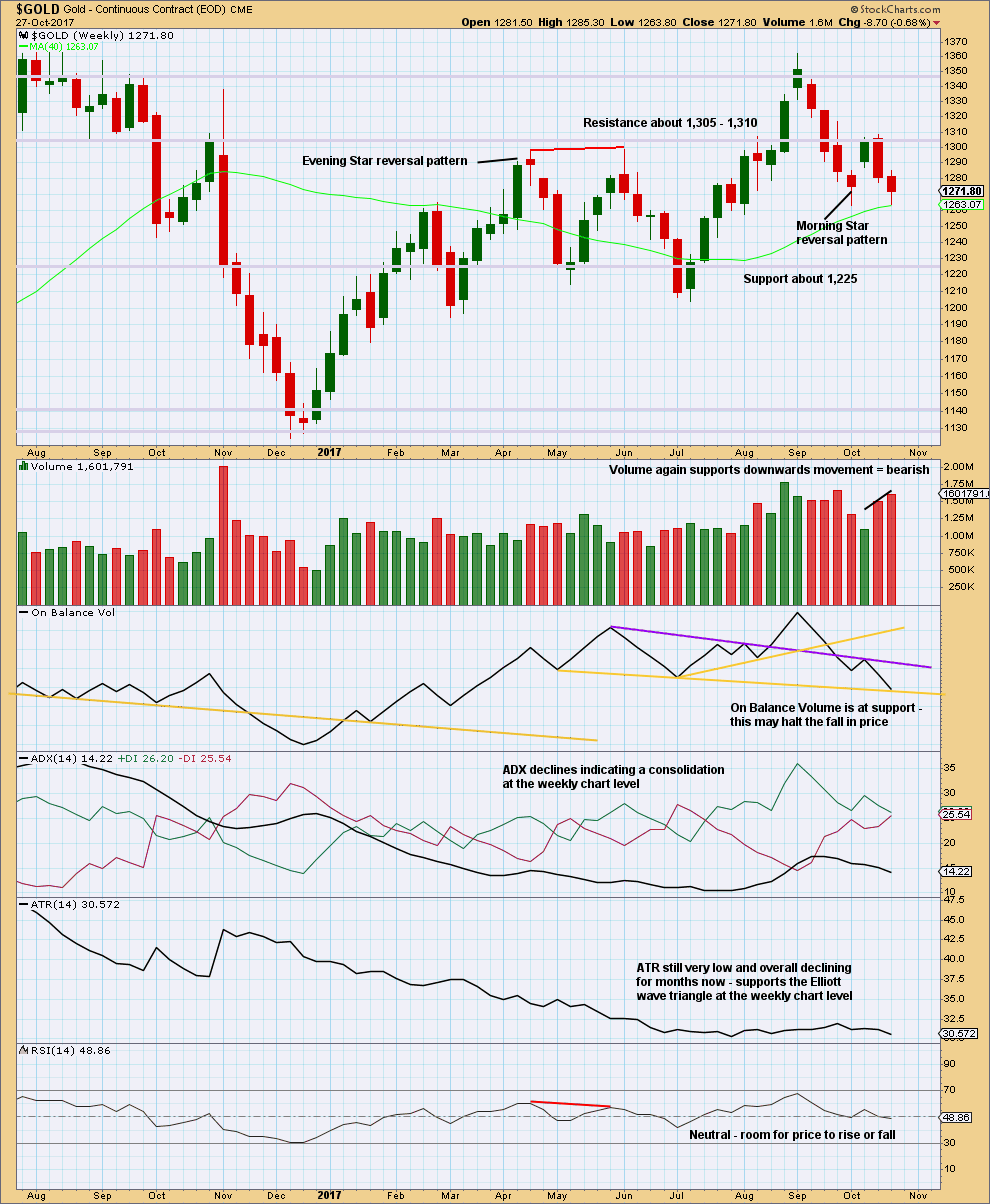
Click chart to enlarge. Chart courtesy of StockCharts.com.
What looks like a possible double bottom here with the last swing low three weeks ago is too small to be classified as a correct double bottom. The two troughs of a double bottom should be about 10% from the peak in between. Here, they are only 3.6% from the peak.
The long lower wick on the last completed weekly candlestick is bullish, but volume tells a different story as it is bearish.
On Balance Volume may again lead the way. Support may force a bounce here.
DAILY CHART
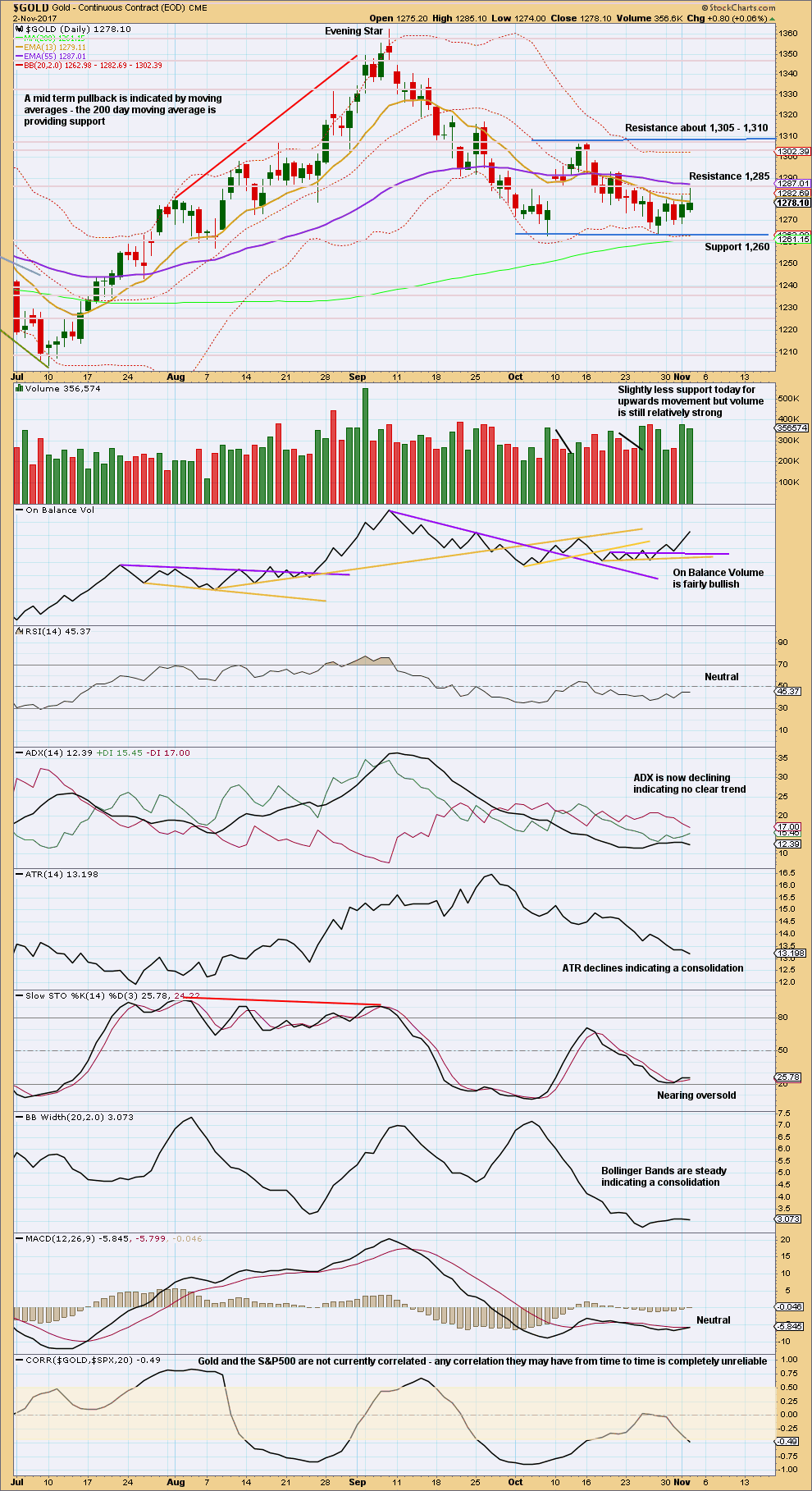
Click chart to enlarge. Chart courtesy of StockCharts.com.
Price is very clearly consolidating. Expect swings from support to resistance and back again. Use Stochastics in conjunction with support and resistance to signal when each swing ends. Be aware that trading a consolidating market is much more risky than trading a trending market, and reduce risk accordingly. Only experienced traders should consider trading the swings within a consolidation. Reduce risk to 1-3% of equity. Always trade with stops. Here, move stops to a little below support and above resistance to allow for overshoots; give the market room to move.
With Stochastics very close to oversold and price at support, an upwards swing may begin here or very soon. Look for resistance about 1,305 – 1,310. This also supports the second Elliott wave count.
On Balance Volume is increasingly bullish today, and volume remains reasonably heavy although it shows a slight decline from yesterday. These two indicators still support an upwards swing here.
GDX DAILY CHART
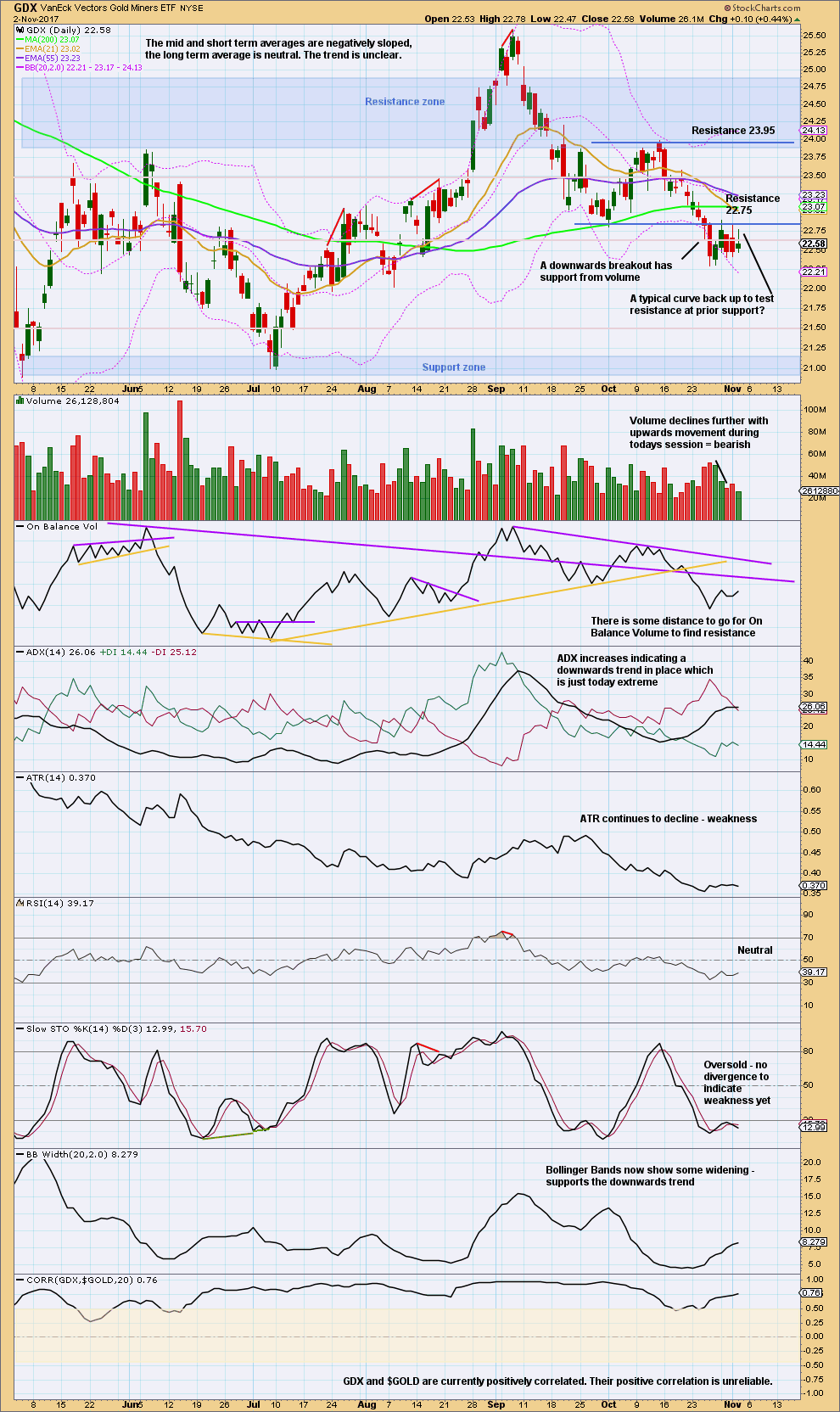
Click chart to enlarge. Chart courtesy of StockCharts.com.
GDX broke below support five days ago, on a downwards day with support from volume. This looks still like a classic downwards breakout. It is common after breakouts for price to curve back and test support or resistance, and that looks like what is happening.
The longer upper wicks on the last two daily candlesticks look bearish. It looks like GDX may now begin to move down and away.
However, volume continues to decline as price is essentially moving sideways; another small consolidation looks to be completing here.
If price moves back above resistance at 22.75, then the consolidation zone may have to be widened. If this happens, then expect an upwards swing to next resistance about 23.95.
But the bottom line for GDX today is it is in a downwards trend. Assume GDX remains so while price remains below resistance at 22.75. With weakness still, traders should take profits or keep trailing stops tight.
Published @ 08:06 p.m. EST.

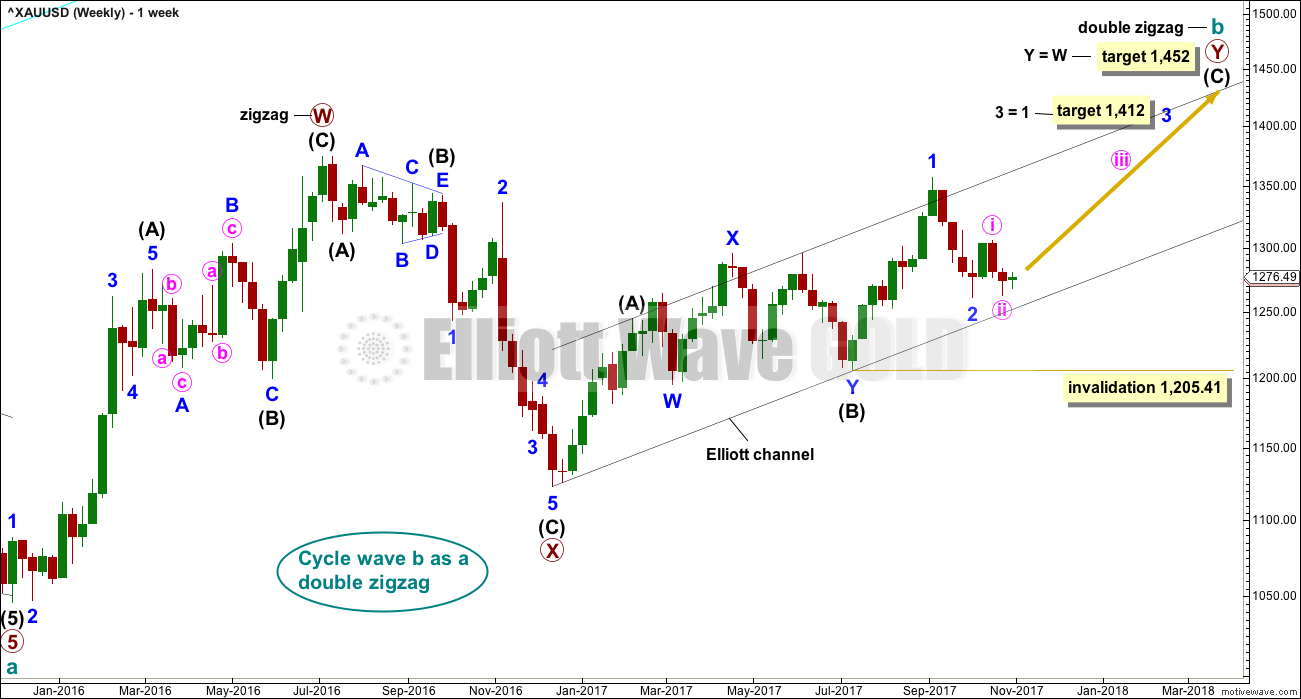
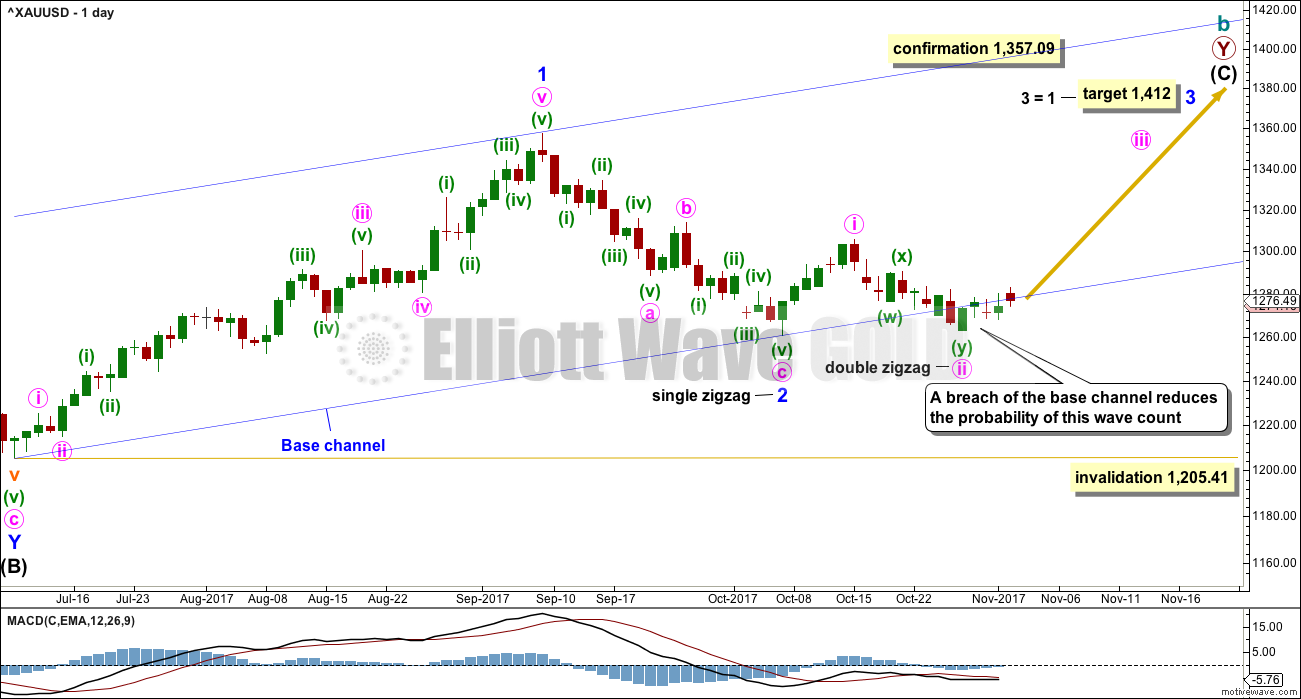
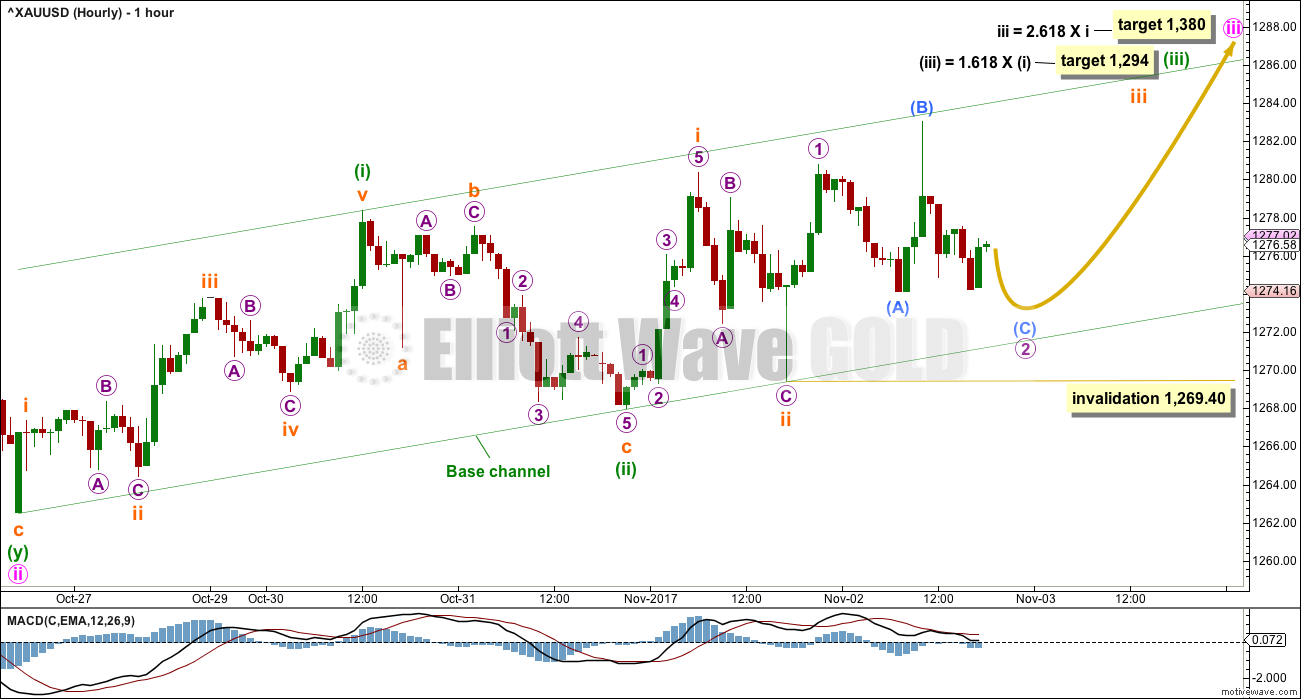
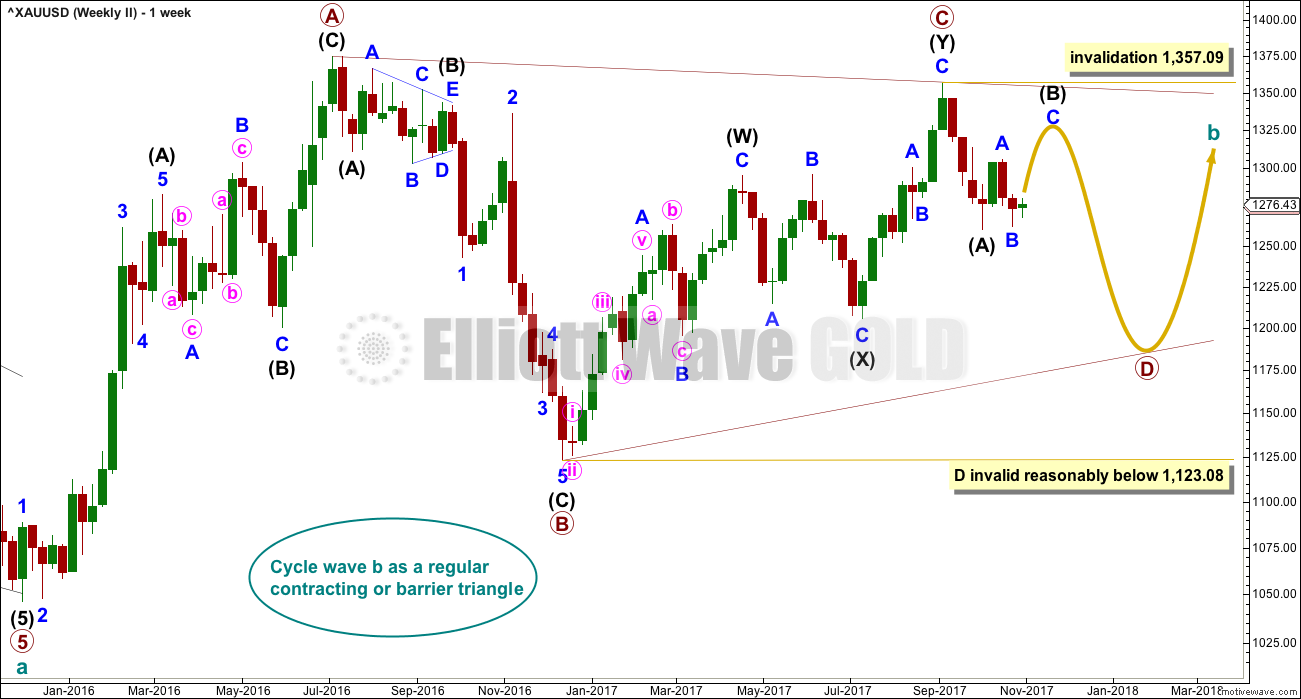
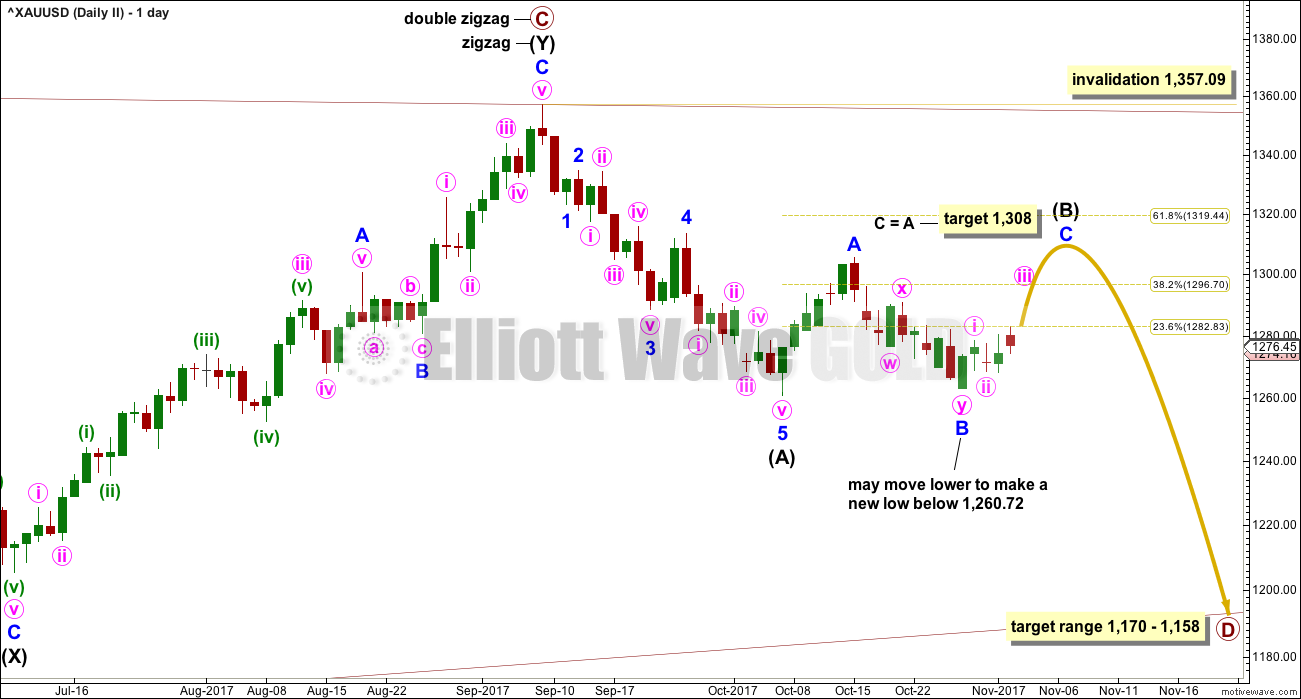
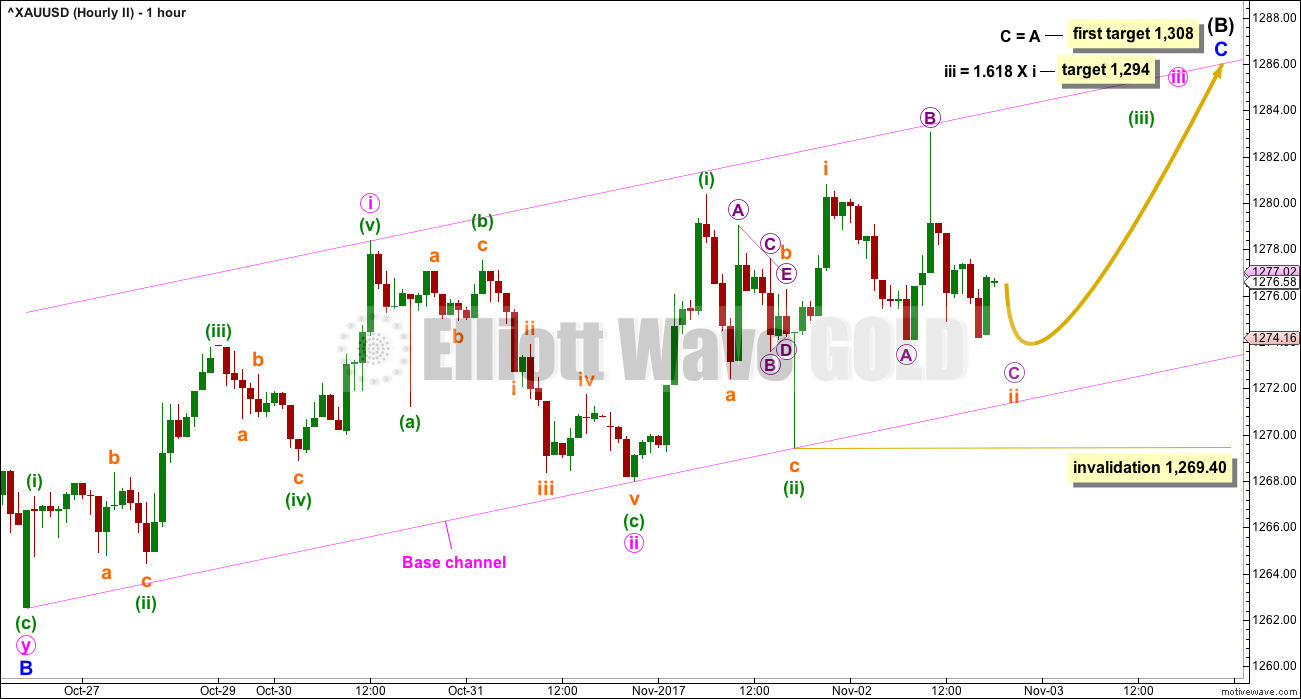
While price remains above 1,262.50 then assume minute ii (first count) and minor B (second count) is complete.
This invalidation and big move down could be a continuation of a second wave correction within a new upwards trend… the trend may still be a short lived upwards swing within the consolidation which is described on the TA chart.
For the 1st count, I think gold may make a new low below the Oct 6th low at 1,260.72 and it will be Minor 2 continuing lower. This will create a new base channel and resolve the overshoot issue.
I buy this. It would fit neatly with USD as well, IMHO. The pink “010” “020” etc are for minute waves as I cannot create a circle around the numbers!
Yes, the dollar may top within the next 2 weeks.
Have you tried TradingView? You have access to all the EW patterns and wave degrees and you can match the colors to Lara’s.
Sorry Dreamer, I did not see this response from you earlier. My apologies.
No, I have not tried TradingView. Let me try that, thanks a ton.
Yes, that is entirely possible. Minor 2 could be continuing lower.
I’d have to resolve the problem of subdivisions though. It couldn’t be a double zigzag or combination or flat, so it can only be a single zigzag.
GDX has been lethargic the last several days as Gold has chopped slowly higher. It now looks like GDX may be forming a small Barrier triangle for Minute 4. If this is correct, a quick short drop of about 2.5% may occur on Fri/Mon.
As Eli has stated, the move may be triggered by the NFP report due out Friday AM.
This chart is my update to the Barrier Triangle Count from Lara at one wave degree lower.
Lets see how this works out.
https://www.tradingview.com/x/GJnbd2zj/
Yep. Price action looking quite bearish these days… 🙂
Hi Dreamer,
Does today’s drop to 22.22 count as B? Also, when GDX finally gets going again do you see the target $27.50 where C ends in early December? Thanks
Hi loveandpeace,
The 22.22 low today was likely the end of a Minuette wave 3 downward breakout from the small triangle. If the bigger Barrier Triangle scenario is correct, then price likely only needs to make one new low below 22.22 to finish the bigger triangle. While my target is now refined to between 22.14 and 22.03, it does not have to go that low, it just needs to go below 22.22.
So, if this occurs as described, it will be a major trend change and then a strong move up should begin that will take up to 6 months with a minimum target above the 2016 high at 31.79.
There are other scenarios, as Lara has shown, but the triangle scenario is still my top count. Hope this helps.